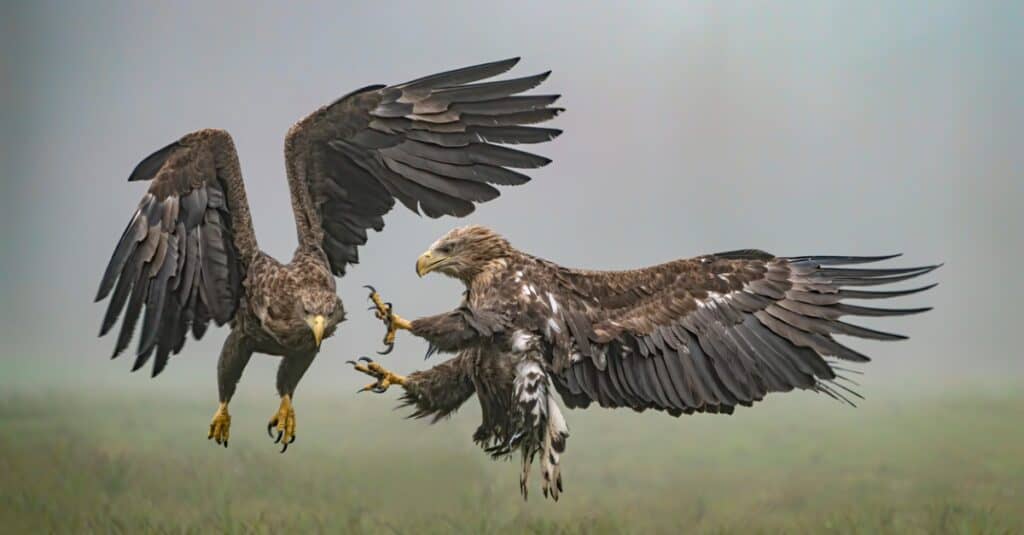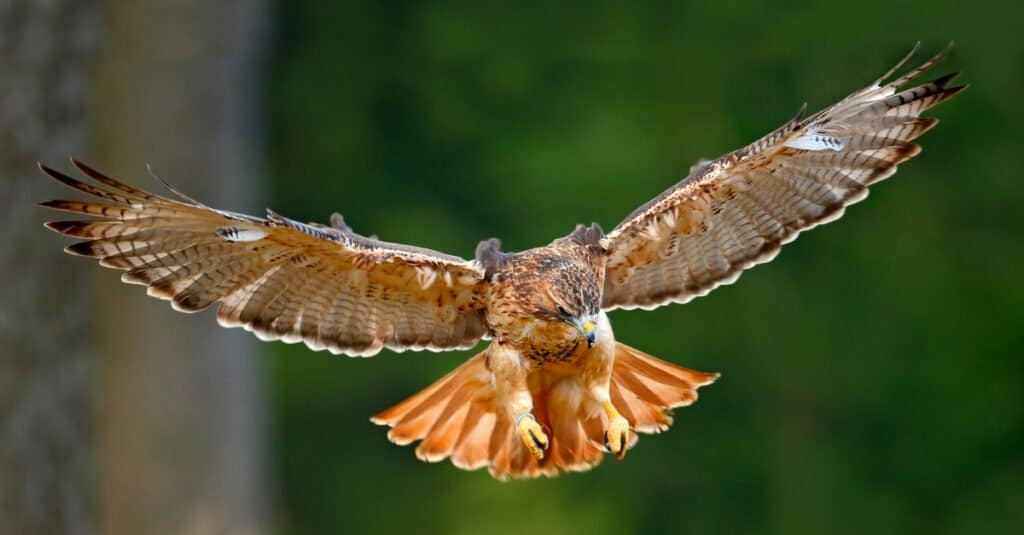Look at that bird in the sky! Is it a hawk? Is it an eagle? If this sounds like you, don’t worry. Many people struggle to tell the differences between a hawk vs eagle, and it’s easy to see why. Hawks and eagles both belong to the family Accipitridae. Both birds tend to hunt during the day and sleep at night. Furthermore, there is no particular difference in their feathering, color, habitats, or distribution, although hawks are more widely distributed. Given that there exist more than 200 species of hawk and 60 species of eagle, how can you differentiate between a hawk vs eagle?
In truth, most scientists differentiate between hawks and eagles based on their size. Overall, eagles measure larger than hawks. Due to their larger size, they generally possess more strength, which allows them to hunt a wider variety of prey. That said, there are a few other differences separating these large raptors. In this article, we’ll discuss six key differences between a hawk vs eagle. We’ll also answer some frequently asked questions about the two in case there’s anything we don’t cover during our comparison. Here are six ways that you can distinguish between a hawk vs eagle.
Comparing Hawks and Eagles

Eagle species are divided into four categories including fish eagles, booted eagles, snake eagles, and harpy eagles
©Albert Beukhof/Shutterstock.com
The family Accipitridae includes at least 12 different subfamilies, most of which include some hawk species. Types such as goshawks and sparrowhawks include multiple species, while some individual species are widely distributed, such as the red-tailed hawk. Depending on the region, some birds go by different names, and this can lead to considerable confusion. For example, some people call ospreys “fish hawks,” while others refer to peregrine falcons as “duck hawks.” Although these names may still enjoy wide usage in some areas, neither ospreys (Pandionidae) nor falcons (Falconidae) belong to the same family as hawks or eagles. In addition, hawks belong to the genus Buteo and often go by the name “buzzard” in some areas, usually in Europe and Asia. Although language exists to distinguish buteonine hawks from accipitrine or “true hawks,” most distinctions are relatively arbitrary.
Meanwhile, scientists usually group eagle species into one of four categories. These include fish eagles, booted or “true eagles,” snake eagles, and harpy or “giant forest eagles.” The different groups exist to help researchers group separate birds together based on specific traits. For example, fish eagles typically eat a diet heavy in seafood, while snake eagles adapted to eat reptiles. On the other hand, booted eagles sport feathers on their legs, and harpy eagles primarily live in tropical forests. Although they may seem minor, these classifications help scientists to compare and classify birds. In turn, comparisons give us a window into their lives and help conservationists predict potential threats to the health of a particular bird population.
| Hawk | Eagle | |
| Size | 7.9 to 27 inches long 2.5 ounces to 4 pounds | 15 to 36 inches long 1 to 21 pounds |
| Wingspan | 15 inches to 60 inches | 33 inches to 9.4 feet |
| Strength | Grip strength up to 200 psi Can carry animals up to 4 pounds | Grip strength up to 400 psi Capable of lifting up to 20 pounds |
| Diet | Small birds, mice, chipmunks, squirrels, frogs, snakes, insects, rabbits, lizards, crabs | Small birds, waterfowl, squirrels, prairie dogs, raccoons, rabbits, fish, frogs, snakes, lizards, small deer, |
| Sounds | Usually described as a hoarse “screech” | Typically make a high-pitched whistling or piping sound |
| Nests and Eggs | Typically make nests in trees Lay between 1-5 eggs | Make nests on cliffsides or in trees Usually lay between 1-2 eggs |
The 6 Key Differences Between Hawks and Eagles
Hawks and Eagles: Size

The red-tailed hawk’s distinct tail feathers are a result of the molting process.
©Ondrej Prosicky/Shutterstock.com
The main difference between a hawk vs eagle has to do with their respective size. While some overlap exists, with large hawks measuring larger than small eagles, eagles usually represent the larger species. For example, the tiny hawks of Central and South America weigh only around 2.5 to 4.4 ounces and measure a mere 15 inches long at their smallest. Compare this to the largest hawk species, the ferruginous hawk. Females can grow up to 27 inches long and weigh nearly 4 pounds.
That said, the average eagle measures as big or larger than the largest hawk. For example, the Great Nicobar serpent eagle is one of the smallest known eagle species, weighing a little over one pound and measuring between 15 and 17 inches long. While small for an eagle, its measurements are average for a hawk. However, it would look tiny compared to some of the largest eagles. For example, Philippine eagles can measure up to 36 inches long, while steller sea eagles can weigh nearly 21 pounds.
Hawks and Eagles: Wingspan
Another difference between a hawk vs eagle is their wingspan. As with size, eagles typically sport larger wingspans than hawks. The little sparrowhawk ranks as one of if not the smallest hawk species. On average, their wingspan measures between 15 to 20 inches. Meanwhile, the wingspan of a ferruginous hawk can reach up to 60 inches. That said, the large eagles possess wingspans almost double or triple the size of most hawk species. The Great Nicobar serpent eagle’s wingspan measures at least 33 inches, while several species sport a wingspan between 6.5 to 7.5 feet. At their largest, they can measure over 8 or 9 feet, with the current record held by a female wedge-tailed eagle that recorded a wingspan of 9 feet, 4 inches long.
Hawks and Eagles: Strength
As carnivorous birds of prey, both hawks and eagles evolved powerful feet and sharp talons to catch, hold, and rip apart prey. However, due to their larger size, eagles are typically stronger than hawks. One way to measure strength is through grip strength. While the talons of a red-tailed hawk exhibit a grip strength of 200 psi, this pales in comparison to the grips of bald and golden eagles.
According to estimates, the grips of these large eagles can reach up to 400 psi. Another way to measure strength would be to see how much a bird can carry. On average, most birds can carry objects up to their own body weight, although some large eagles and owls can carry objects up to three times their body weight. Given this rule, most hawks could only lift prey weighing around 4 pounds, while many eagles can lift up to 20 pounds.
Hawks and Eagles: Diet

A bald eagle catching a fish
©jbieger/Shutterstock.com
Although some differences exist between the diet of a hawk vs eagle, there are also many similarities. For example, both species tend to prey on small mammals such as mice, rabbits, and squirrels and will also hunt smaller birds such as songbirds or woodpeckers. In addition, some hawk and eagle species adapted to hunt reptiles, such as snakes and lizards, while others evolved to hunt fish. That said, the main difference between their diets is that eagles can also hunt large mammals and birds while hawks cannot. Some eagle species target large waterfowl, such as geese and ducks, while others pick off small deer or goats, particularly infants or juveniles.
Hawks and Eagles: Sounds
It’s a widely held belief that eagles and hawks both make screeching sounds. This belief likely comes from movies and television, which occasionally typically eagles crying out triumphantly while soaring through the sky. In reality, the vocalizations of a hawk vs eagle sound quite different, and the distinguishing features may surprise you. Most adult hawks make hoarse, screeching sounds that we associate with large birds of prey. On the other hand, many eagles tend to emit short, high-pitched chirps or piping sounds.
Hawks and Eagles: Nests and Eggs
Another difference separating a hawk vs eagle concerns their nests and eggs. Most hawk species exclusively build their nests in high trees. Although some species lay as few as 1 to 2 eggs, many hawk species lay between 3 to five eggs at a time. On the other hand, eagles may build their nests in trees or on cliffsides. For example, while bald eagles prefer to build their nests in trees, golden eagles generally prefer to build their nests on cliffsides. In addition, due to their larger size, most eagles only lay 1 to 2 eggs at a time.
Can Eagles Defeat Hawks?

Hawks are listed as one of the main food sources of the eagle.
©PHOTOOBJECT/Shutterstock.com
Both the eagle and the hawk have different qualities when it comes to fighting style and their qualities work well for both of them. It may appear that the eagle would be the victor at all times, and while it may appear that the eagle would always be the victor, there may be some factors that could inhibit this. The top reasons for the potential defeat of the majestic eagle are age and health.
A young eagle may not yet have the advantage of being a skilled hunter and an older one, or one that may be sick or injured, may not have the ability to attack as well as it once did. However, Hawks are listed as one of the main food sources of the eagle and the likelihood of an eagle being overcome by a hawk is extremely rare. There is no evidence of a hawk ever having taken down this larger bird of prey, while the success rate for the eagle against the hawk is incredibly high.
Frequently Asked Questions Concerning Hawks and Eagles
How well can hawks and eagles see?
Both hawks and eagles possess keen eyesight. Some species and distinguish small mammals hiding in cover up to 2 miles away, and scientists estimate their eyes are 5 to 8 times stronger than ours.
How fast can hawks and eagles fly?
Hawks and eagles can both reach incredible speeds, especially during a dive. Red-tailed hawks can reach up to 120 miles per hour, while golden eagles can reach speeds of 150 to 200 miles per hour.
The photo featured at the top of this post is ©
Thank you for reading! Have some feedback for us? Contact the AZ Animals editorial team.






